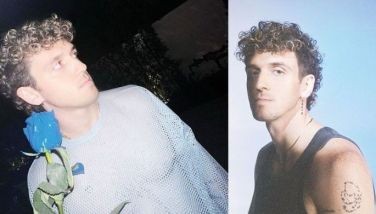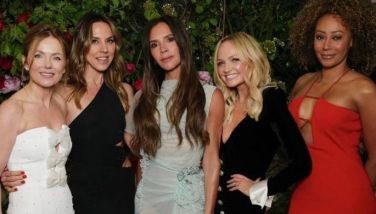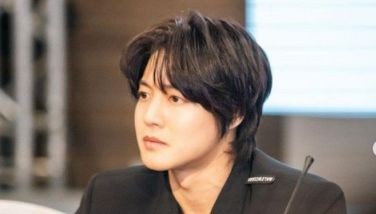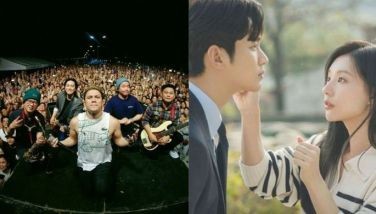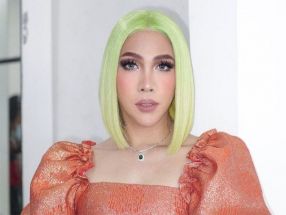‘Solo: A Star Wars Story’: 12 things to know

HOLLYWOOD — Lucasfilm presents “Solo: A Star Wars Story” charts the adventure-filled past of Han Solo, the iconic galactic scoundrel and one of the most beloved characters in cinema history.
Through a series of daring escapades deep within a dark and dangerous criminal underworld, Han Solo will meet his mighty future copilot Chewbacca and encounter the notorious gambler Lando Calrissian, in a journey that sets the course of one of the “Star Wars” saga’s most unlikely heroes.
Directed by Ron Howard, the fun-filled galactic heist movie stars Alden Ehrenreich (“Hail, Caesar!,” “Tetro”), Woody Harrelson (“Three Billboards Outside Ebbing, Missouri,” “The Messenger”), Emilia Clarke (“Me Before You,” “Game of Thrones”), Donald Glover (“Spider-Man: Homecoming,” “The Martian”), Thandie Newton (“Gringo,” “Crash”), Phoebe Waller-Bridge (“Fleabag,” “Killing Eve”) and Paul Bettany (“Captain America: Civil War,” “Master and Commander”). Joonas Suotamo (“Star Wars: The Last Jedi”) returns to play Chewbacca.
To create the unique look of the film, some of the industry’s top talents have been recruited, including Academy Award nominee Bradford Young (“Arrival”), director of photography; two-time Academy Award–winning editor Pietro Scalia (“Alien: Covenant”); Dominic Tuohy (“The Mummy”), special effects supervisor; Rob Bredow (“Cloudy with a Chance of Meatballs”), visual effects supervisor; and John Powell (“Jason Bourne”), score composer.
They are joined by returning “Star Wars” veteran crew members: Neil Lamont, production designer; Neal Scanlan, special creature effects; David Crossman and Glyn Dillon, costume designers; Jamie Wilkinson, prop master; Lisa Tomblin-Fitzpatrick, hair designer; and Amanda Knight, makeup designer.
The legendary John Williams is credited with the “Han Solo Theme” and original “Star Wars” music.
“Solo: A Star Wars Story” is set for release in U.S. theaters on May 25.
1. Solo is the second story film from Lucasfilm
The camera is turned on Han Solo, the legendary smuggler with the heart of gold, in “Solo: A Star Wars Story,” the second story film from Lucasfilm, following 2016’s mega hit “Rogue One: A Star Wars Story.”
Producer Kathleen Kennedy, describing what makes Han Solo such an iconic and beloved character, and one whom Lucasfilm was inspired to feature in a film, says, “He’s very authentic. He’s a scoundrel, he’s a maverick, and there’s a mystery to him. Handsome, incredibly charismatic and adorable—that’s a pretty great combination for a Star Wars action hero.”
2. George Lucas always wanted a Solo movie
Interestingly, the “Solo” project was one of the first George Lucas talked about when he outlined his plans to Kennedy for the “Star Wars” stand-alone stories. They both agreed that Lawrence Kasdan, writer of “The Empire Strikes Back” and “Return of the Jedi,” would be the perfect person to pen it. “Larry Kasdan knows Han Solo better than anybody,” says Kennedy. “Given his long association with Star Wars, and deep understanding of Han Solo’s character, there was no one better to tell the story, and preserve the spirit and feeling of the original movies.”
Writer Lawrence Kasdan was hooked the moment he found out the film was about Han Solo, the character he is most passionate about in the Star Wars canon. “Han was always my favorite, right from the start,” says Kasdan. “He’s the most exciting guy in the saga for me. He’s unpredictable. He’s reckless. He’s not brilliant. He’ll say things that he can’t back up. He’ll leap in when he should stay back. There’s nothing more attractive to me than a screw-up who’s actually got a good heart but hides it as best he can.”
During production on “The Force Awakens,” the veteran screenwriter found himself in the unique position of penning a new Han Solo adventure while witnessing the character’s death on set. It was a rare moment for any writer, and an opportunity he could not wait to explore.
3. Han Solo is inspired by Westerns
Kasdan cites Han’s introduction in “Star Wars: A New Hope” as the primary inspiration for exploring the character’s backstory in “Solo.” “I’ve made two Westerns, and there’s nothing more Western than the Mos Eisley Cantina in A New Hope. In walks the gunfighter—he looks like a gunfighter, he sits like a gunfighter, he shoots like a gunfighter—and I thought, what happened before this guy walked in the door?”
Sharing Kasdan’s love for Westerns is his son and “Solo” co-writer Jonathan Kasdan, who has been a lifelong fan of the Star Wars movies and of Han Solo in particular. Growing up in a “household of Star Wars,” as his father likes to say, Jonathan remembers the films as being extremely influential on his development as both a writer and director. It was his enthusiasm for Han Solo, and intimate familiarity with the Star Wars universe, that formed a highly productive and creative rhythm between the two writers.
“I come at this as a fan who thinks of these stories as written in stone, while Larry comes at it as a dramatist who thinks of them as tools,” says Jonathan. “And because I’m more of a Star Wars geek than he will ever be, it formed a dynamic between us which determined how much of the lore we were going to be beholden to and how much we were going to go our own way. I think that my reverence and Larry’s confidence complemented each other well in the writing process.”
Jonathan Kasdan, who was on set during the entire production of “Solo,” saw Alden Ehrenreich’s performance bring young Han to life. “Han is confident and funny, yet self-conscious and relatable. Alden is perfect in the role, and it was a marvel watching him perform,” comments the writer.
4. The movie shines spotlight on Solo and Chewbacca’s friendship
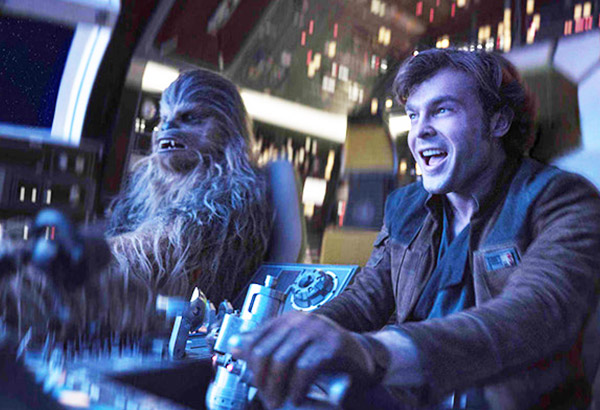
Lucasfilm/Released
One aspect of the story that both writers were determined to explore further than previous films is the relationship between Han and Chewbacca. As a father-and-son writing team, each found the inseparable duo one of the most endearing qualities of the original Star Wars movies.
“I love that relationship,” says the elder Kasdan. “I love all the qualities that are embodied by it. There’s courage, there’s teamwork, there’s loyalty and there’s a slightly canted view of the world. Their relationship is reassuring, recognizable and speaks to the best in each of them.”
“They had that great partnership,” agrees Jonathan. “It was loaded with love, was never cruel or hostile, and was just a real intimacy.”
Just as important to both Kasdans was creating a story that was unlike any other Star Wars film before it. They wanted “Solo” to be the most character-filled and character-focused story yet, but one that still honors the legacy of the saga. “This is a story that comes out of old-time storytelling,” says Lawrence. “It’s a story about someone being forged in the crucible of life—in danger, in violence and in love. It’s about how a person is formed.”
“Other people will judge if that’s true,” he continues. “But for me, that part has been totally achieved.”
5. The movie tells Han’s coming-of-age story
Director Ron Howard, a self-avowed Star Wars fan, whose friendship with George Lucas goes back to Lucas’ early film, 1973’s “American Graffiti,” appreciated the merit of this father-and-son writing team. “Larry Kasdan is the greatest resource, not only his sense of Star Wars, but his overall sense of movies and movie heroes, where those muscular action situations intersect with character and test the character in ways that are thematically interesting, and sometimes moving and surprising. Jon loves movies, and he is encyclopedic about them. He thoroughly understands what’s great about Star Wars, what’s great about Han Solo, as a classic movie character. But, critically, he also has a cutting-edge sense of humor and a contemporary sensibility.”
Adds Howard, “This film is charged with youthful energy and cool. While it had to be true to the aesthetic and sensibility of Star Wars, we also wanted to push the envelope to make it work for young audiences, so it would feel more relatable than nostalgic. And yet, in a way, this is the first real character study in the galaxy so far for fans. The story very much reflects the spirit of the original movies in the combination of playfulness, thematic focus, mixed with great action, and a universe that is fascinating, inviting, entertaining and a little bit thought-provoking.”
“Solo” explores Han Solo’s formative years and follows his journey through a series of impactful encounters, combining themes of trust, loyalty, love and betrayal with light-hearted humor, wit and rollicking action. As Howard explains: “This is a rite-of-passage story, consistent with Star Wars, with many themes that will resonate with audiences. It’s about one character’s journey, the way that he is tested by the unique challenges that he faces and by the people he meets, to become the character we know so well.”
6. The movie had a hard time finding a young Harrison Ford counterpart
“Solo: A Star Wars Story” features an exciting cast of both emerging and veteran stars in its impressive lineup.
The filmmakers had a big challenge casting Han Solo. Says Kennedy, “Harrison Ford is so unique and has embodied the character for so many years that they were gigantic shoes to fill. We weren’t looking for someone who looked like Harrison; we didn’t want an impersonation of him nor his Han Solo. We wanted an actor who could find those traits that are so lovable, so roguish, about Han Solo.”
Alden Ehrenreich was one of the very first actors the filmmakers saw. He was not widely known to mainstream audiences but had caught the filmmakers’ attention, and the critics’ alike, with his scene-stealing performances in “Hail, Caesar!,” “Blue Jasmine” and “Rules Don’t Apply.”
Producer Kathleen Kennedy comments, “Alden tapped into the things that make the character special but without imitating Harrison. He captured the essence, that maverick spirit. He was funny and charming, cool and handsome. He had all those qualities, but he also had that hidden vulnerability specific to Han. It was a very intuitive portrayal.”
Ron Howard concurs, “Alden is thoughtful. He’s an artist, and he’s very passionate about his work on a very pure level. He has thrown himself into creating this character, not as an imitation of Harrison but understanding the connection between Harrison, the Han Solo character and his own instincts that can connect him to the character in similar ways.”
As a major fan of the Star Wars films, Ehrenreich was thrilled when he learned he had the role. “It’s really special to be part of a franchise that has so much heart and that means so much to people, and to play such a multi-dimensional character in the Star Wars universe.”
Ehrenreich recognized the responsibility of taking on the role of such a beloved iconic character, and he was raring to go: “There are so many things referenced in the original movie that the audience will get to see. Han meeting Chewie for the first time. Han’s first encounter with Lando. The Kessel Run. Han getting his blaster. And all the people Han encounters, the turns those relationships take, they have much to do with the person Han becomes. It was all a really thrilling prospect.”
He was excited about the filmmakers’ approach to the material as well. “I loved their vision,” Ehrenreich says. “I loved the humor and the angle they were coming from. It’s a big epic adventure story with a crew of people at the heart of it that you care about, and who care about each other. But because of Han’s nature, the world he grew up in and the people he meets, there’s an edge to the story, and a toughness, which gives it a really cool vibe.”
Ehrenreich had a positive experience working with director Ron Howard, and says, “Ron came with an uncanny sense of Star Wars. He spoke the language, he knew the humor and he had takes on the scenes that were really clear and specific. He has so much energy and clearly loves making movies, and that was infectious to be around. He also understands actors on a really deep level, not least of all because he was one, and being the beneficiary of that level of understanding was wonderful.”
Alden has worked with some of the foremost directors in Hollywood, including Francis Ford Coppola, Ron Howard, the Coen Brothers and Sofia Coppola.
This summer, Ehrenreich will star in the film “The Yellow Birds,” directed by Alex Moors and released by Saban Films. He plays the lead role of a young soldier who has been exposed to the horrors of war in Iraq, and subsequently covers up the death of his best friend. In 2016, Ehrenreich garnered critical attention for his scene-stealing role as Hobie Doyle in the Coen Brothers film “Hail, Caesar!,” alongside Josh Brolin and Ralph Fiennes.
Ehrenreich made his film debut in 2009 to critical acclaim, playing the lead in Francis Ford Coppola’s semi-autobiographical film “Tetro.” Additional film credits include Warren Beatty’s “Rules Don’t Apply”; “Blue Jasmine”; “Beautiful Creatures”; Focus Features’ “Somewhere,” directed by Sofia Coppola; “Twixt,” directed by Francis Ford Coppola; and Fox Searchlight’s “Stoker.”
Ehrenreich began directing and starring in student films in junior high and high school. After, he attended the prestigious Gallatin School at New York University. While there, he created The Collectin, a collective that crafted plays and films tailor-made to the strengths of its actors and writers. They created six original plays, five short films and one feature film, “Running Wild.”
Ehrenreich currently resides in Los Angeles.
7. Qi'ra is Han’s first love
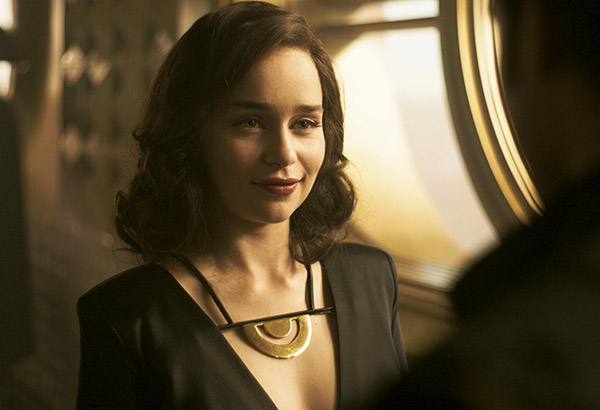
Lucasfilm/Released
Emilia Clarke, who plays Qi'ra, says of her co-star, “Alden’s an incredible actor who is beyond capable of doing this role justice. He has put a staggering amount of work into it. He brings that Han Solo swagger, that energy and that spirit, and he’s so endearing.”
Qi'ra, Han’s first love, is played by one of the U.K.’s most talented and popular actresses, Emilia, known for “Game of Thrones.”
“Qi'ra is probably the most complex character in the film,” says producer Simon Emanuel. “Emilia is a wonderful actress and has an amazing ability to convey the enigmatic qualities that Qi'ra possesses. What you see on the surface is not necessarily what’s going on underneath.”
Howard adds, “Emilia is wise beyond her years in a way I really admire and appreciate. Understanding Han’s relationships with women on a more emotional level is helpful in broadening out the character, understanding what makes him tick and what’s he’s capable of feeling. Emilia really understood that, in order to learn more about Han, we needed to see a very dimensional female lead.”
Clarke was excited to join the Star Wars universe and admits to “geeking up” on Star Wars to get her performance pitch-perfect. “It’s really exciting to be creating a new, strong female character in the Star Wars universe, especially one who is integral to the story of such a beloved character in cinema history.”
About the relationship Qi'ra has with Han, Clarke says, “When we join Han and Qi'ra, we crash into their existence, both teenage urchins, surviving life on the streets in an unforgiving world. They love each other, but at that moment they get ripped apart. When Han finds her again, she’s second-in-command to a dangerous mob boss, in the heart of this gangster life. The independent survivor spirit within her is still there but has merged forces with this sophisticated, whip-smart, ambitious woman.”
Can Han trust her? “I think she has done some dark things,” comments Clarke. “Han softens her. She’s bound to the lifestyle she has found herself in to survive, but she will always hold the torch for Han, and it’s that realization, that reminder, which keeps her human and keeps her in this ambiguous place of whether she’s good or bad.”
Alden Ehrenreich comments on Clarke and her portrayal of Qi'ra, saying, “She’s the love of Han’s young life. He dreams about having his own ship and traveling the galaxy with her to escape the dark totalitarian world and call his own shots. Emilia is wonderful at the mysterious aspects the role demands. She’s very detailed, very specific, which makes Qi'ra such a dynamic character. She’s very evocative on screen, very compelling to watch, and she has a wicked sense of humor.”
Clarke is currently filming the eighth and final season of the HBO award-winning series “Game of Thrones,” a role that has garnered three Emmy nominations and three Critics’ Choice nominations for her beloved portrayal of Daenerys Targaryen, the Mother of Dragons.
Clarke recently wrapped production on “Above Suspicion,” opposite Jack Huston. Huston plays an FBI agent who moves to a remote mining town in Kentucky to build a case against a stolen truck ring. However, when he develops a relationship with one of his informants, a troubled, obsessive woman named Susan Smith (Clarke), he soon finds himself committing adultery and murder.
Other film credits include the wildly successful “Me Before You,” the screen adaptation of Jojo Moyes’ best-selling novel of the same name, which grossed over $208 million worldwide. The story follows a young woman (Clarke) who forms an unlikely bond with a recently paralyzed man (Sam Claflin) she’s taking care of. Clarke also portrayed the iconic role of Sarah Connor in “Terminator Genisys,” a prequel to the popular box-office franchise, opposite Arnold Schwarzenegger. She also co-starred in “Dom Hemingway,” opposite Jude Law, and “Spike Island,” directed by Mat Whitecross.
In 2013, Clarke made her Broadway debut as Holly Golightly in the stage adaptation of Truman Capote’s classic 1958 novella, “Breakfast at Tiffany’s.”
After graduating from the Drama Centre London, Clarke began her career with a guest-starring role in the BBC series “Doctors” and a co-starring role in the U.S. made-for-television movie “Triassic Attack.”
Clarke currently resides in London.
8. Chewbacca is portrayed by a basketball player
The closest relationship Han Solo has is with Chewbacca, played by former college basketball player Joonas Suotamo. Chewbacca is central to the action in “Solo: A Star Wars Story,” which gave Suotamo a real opportunity to embrace the character.
Says Suotamo, “Chewbacca is truly the most loyal companion. He’s very attentive, always alert to danger because he’s lived such a long, dangerous life, always on the watch. He is the perfect partner to have watching out for you. It becomes clear to Chewbacca that Han needs someone to take care of him.”
The actor adds, “Han’s too much of a risk-taker, overconfident that he can accomplish any task. Chewbacca is there to tell him that maybe he needs to think first. It brings enormous fun into the scenes.”
Says Ehrenreich of their special relationship, “It’s like watching a married couple. There’s an unspoken closeness. They are always bickering, but at the end of the day there’s a deep and unbreakable bond. Chewbacca is very emotional, very loyal, and cares a great deal about Han.”
About his co-star Suotamo, Ehrenreich comments, “One of the things audiences respond to with Chewbacca is his big open heart, and, while he has to be mindful of all the technical requirements involved in moving in the suit, Joonas was really able to bring so much to the performance, so much heart in what he does, and that’s really impressive.”
9. The film was mostly made in UK
The filming of “Solo: A Star Wars Story” took place mostly at Pinewood Studios in the U.K., as well as two foreign locations in the Dolomites and Fuerteventura, settings equally stunning in very distinctive ways.
The task of designing the sets fell to production designer Neil Lamont. A Star Wars veteran following his work as co-production designer on “Rogue One” and supervising art director on The Force Awakens, Lamont was thrilled to return to the Star Wars universe. “It’s such an aspirational story and a journey of such scope for the characters,” comments Lamont. “It was a fantastic creative opportunity to discover and design, build and show audiences such diverse settings, and to realize environments that have been spoken about so often in the past films.”
Lamont was able to refer to an “amazing plethora of material” from Ralph McQuarrie and Joe Johnston, Star Wars’ original concept designers, which was especially helpful in the design of the film, as the filmmakers wanted to capture and preserve the spirit of the late ’60s/early ’70s, with more than a nod to the Western genre. “We cast our research net far and wide, and kept returning to the themes of the Western genre again and again, and it weaves itself in and out each of the sets as a theme and as an overall look,” informs Lamont.
“We have tried to keep the original aesthetic,” adds supervising art director Alastair Bullock, “or at least the spirit of the original aesthetic, while upgrading the build quality and the finishes to modern standards to adhere to the scrutiny and expectation of today’s audiences.”
Corellia
Together with Lucasfilm design supervisor James Clyne, Lamont came up with the idea to present Corellia, Han’s home planet, as a Star Wars industrial version of Venice. The entire planet is made up of archipelagos, connected by bridges. “We asked ourselves how they would create such big spacecraft in this world,” says Lamont. “It just came about that we felt so much could be done over water, by creating these different islands with different functions—administrative or industrial or residential, all interconnected by bridges and roads.”
The various Corellian environments were built across Pinewood Studios and at Fawley Power Station, an oil-fired, disused power station built in the late ’60s and located in Hampshire, in the south of England. Its utilitarian boiler houses and turbine halls hugely inform the overall look and design of Corellia. “We could never have afforded, nor had the space, to build a set that had so much technical depth within it,” notes Lamont, “so once we had found Fawley, and it gave us the concrete structures, the broken-down piping, the general dirty and rusty feel we wanted, the location very much became a foundation to how we imagined the rest of Corellia.”
At Fawley, with additional shooting at the Dunsfold Aerodrome in Surrey, the filmmakers staged one of the film’s most thrilling action sequences: Han’s speeder chase, giving the creative teams the chance to build some fabulous vehicles, and the special effects and stunt teams the opportunity to perform some incredible work.
The development of Han’s speeder was an extended process and an interdepartmental collaboration among the art, action vehicles and special effects teams. Senior art director Gary Tomkins explains their starting point for the speeder design: “We based the design on the American muscle car from the late ’60s/early ’70s, combined with speeder technology, and taking design cues from Luke’s speeder and various other craft seen in the Star Wars universe.”
Vandor
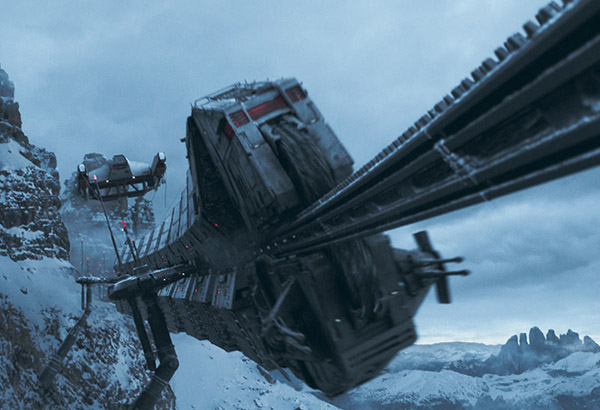
Lucasfilm/Released
To capture the Iridium Mountains of Vandor—a series of snow-capped peaks, picturesque mountain streams and sheer cliffs imagined by the film’s writers, where important scenes, including the Train Heist, take place—the filmmakers wanted an extraordinary location. They chose the Dolomites, a mountain range located in northeastern Italy and making up the eastern part of the Alps.
10. The movie shows the Millennium Falcon in its newer state

Lucasfilm/Released
The Millennium Falcon, arguably everyone’s favorite Star Wars set, is not the Millennium Falcon audiences know and love but a clean version imagined by the filmmakers in its “original” state when it belonged to Lando. The challenge for the filmmakers was preserving the legacy feel as far as possible while presenting a fresher version of it. Audiences have to believe that, at the end of the day when Han gets the Falcon, the ship has evolved from what they see in “Solo” to the version with which they are already so familiar.
The exterior now has a smooth outer shell, the missing panels replaced, and the internal pipes and mechanisms covered up; altogether a much better maintained version than the one with which audiences are familiar. One very important new element is a wedge-shaped escape pod that sits between the front mandibles, with this origin story explaining why the Falcon we know has the shape it does.
The exterior Millennium Falcon set built for “The Force Awakens” and “The Last Jedi” was repurposed. It was situated on Pinewood’s backlot, weighed 31 tons, and it had to be moved around using two cranes. As a result, the Falcon could be seen flying across the Buckinghamshire skies on more than one occasion during the summer months of 2017 as it was repositioned from one space to another in keeping with the narrative demands of the day.
The filmmakers looked for their cues as to how the Falcon might have looked when Lando owned it in the legacy films. Explains Liam Georgensen, art director for the Millennium Falcon and known affectionately among the crew as The Falcon Man: “For example, the padding in the corridors in A New Hope is slightly whiter than it is in The Empire Strikes Back and Return of the Jedi. We took that as a hint that at an earlier time it was a lot whiter, before Han got his hands on it. So what you’re looking at now is a much cleaner version of the corridors. We took that idea and applied it to the areas we don’t see in the legacy films to work some of Lando’s character into the ship, as well as tidying up all the exposed wires and making it much more pristine throughout the areas that audiences know.”
The Interior Millennium Falcon set took three months to build and is the largest interior Falcon set ever made on any Star Wars film. Again, the filmmakers repurposed elements created for The Force Awakens and The Last Jedi, expanding the interior to encompass Lando’s quarters, which boast an extensive walk-in closet and a luxurious sleeping area, a double bed draped in soft fabrics and surrounded by controls and gadgets to keep Lando entertained. Among other pieces, the set decorating team sourced a pair of square dumbbells and a pair of silver headphones, a nod to a similar pair seen in A New Hope, hooked on a seat in the main hold. “We thought it would be fun to suggest those headphones had been kicking around for a while,” says the set decorator, Lee Sandales.
In the lounge, the creative team was tasked to add elements to suggest the Falcon is a more social place under Lando’s guardianship. A chandelier has been added over the familiar chess table, and some yellow protective covers to the seating area. The area now offers a bar, a circular ottoman seat with integral music system and a brand-new navigation system control, which retains some elements of the older version but is a much slicker and well-maintained piece of machinery.
There is also a trophy case, containing Lando’s prize possessions, including a miniature replica of the Falcon itself, 3D printed from the working model that was made for the build of the exterior ship, a speeder bike model, as well as a model of Cloud City. Yellow upholstery throughout is inspired by the color of Lando’s shirt.
The filmmakers have also added the engine room to the interior, an area that has only been hinted at in previous Star Wars films. Says Georgensen, “What we’re showing is only a tiny part of the inner workings of the ship, perhaps just an area accessible for maintenance and for giving it a little speed boost when needed, but the idea is to hint at the more industrial side of the ship, which later becomes more exposed once Han has had his way with it.”
Utmost respect was paid to the original design when it came to revamping the cockpit. “We were very careful with what we did to the cockpit, but there is still an element of Lando about it, fresh upholstery on the chair, a little pop of yellow on the back seats,” says Georgensen. The filmmakers repurposed the cockpit set made for The Force Awakens and The Last Jedi, but all the control panels were completely remade and, while there are extra switches, every LED is in exactly the same place as it is in the original films. There were also requirements to make the cockpit as practically interactive as possible, so every switch had to work. They also had to provide plug-in ports on the right-hand side of the cockpit with which L3 could interact.
The Millennium Falcon is exposed to some extreme turbulence during the film, and it fell to the special effects team to create the movement, which they did with a combination of gimbals and purpose-built rigs. “We make it move to look like it’s really in trouble,” says Dominic Tuohy. “It’s not a camera shake. The set is actually shaking, and we’re moving it five degrees either way and very violently, which allows everything in that set to vibrate and move so you get that natural movement. The actors aren’t trying to move; physics is taking over. They’re actually trying to hold on.”
For the first time, visual effects utilized rear-projection wrapping screens the height of the soundstage 180 degrees round the cockpit so the actors could see and react to pre-prepared animations rendered by ILM of flying and entering hyperspace. Explains Rob Bredow, “We generated the shots very much the same way it is done for a simulator ride in an amusement park to make it as immersive and realistic as possible, not just for our actors but for the camera, and primarily for the audience. It completely changes the character of the lighting on the actor’s face so you can actually see hyperspace in Han’s face. As Han Solo goes into hyperspace for the first time in the Millennium Falcon, it is reflected in his eyes. Those are shots that would be impossible to get without this technology.”
11. The movie used over 1,000 costumes
The costume design team, headed by David Crossman and Glyn Dillon, made over 1,000 costumes for “Solo.” The majority of the costumes were designed and produced in house, and the stand-out costumes for the crowd scenes ranged from wide-brimmed hats and fringed jackets, to colorful indigenous costumes of the nomadic tribes, and all the way to high-fashion looks.
For David Crossman, designing the costumes for “Solo” was a dream come true. “Han Solo is my favorite character from the original trilogy films,” says Crossman. “He’s just the epitome of cool, and it is such an iconic look to explore.”
Glyn Dillon adds, “The characters that Han meets throughout his journey also are so layered, so rich, they presented fantastic opportunities for us as designers.”
What makes a Star Wars costume? “It’s something real, that audiences can relate to from their own life and from history, mixed with fantasy elements, that gives it the Star Wars feel,” suggests Crossman.
Remaining faithful to the aesthetics of the original costume design, and taking inspiration from other 1970s references, often Western ones, including Robert Altman’s “McCabe & Mrs. Miller,” the costume team created a wonderful wardrobe of clothes for principal cast, creatures and a huge number of crowd players.
“Han Solo’s look is such a classic, iconic one, so we didn’t want to veer too far away from the original costume,” informs Crossman, “but we wanted to see how he got there. We liked the idea that the look becomes Han Solo during the course of the film as he acquires pieces from Beckett, and from other characters. The more people he meets, the more he gathers and establishes his own identity.”
The designers had several looks to create for Han on his costume journey, which include Han’s Corellian look. Says Glyn Dillon, “We were looking at bands like The Clash for inspiration, and we arrived at an ’80s punk look mixed with a ’50s element.”
The costume consists of a leather waistcoat vest, painted in white house paint, a sign he “belongs” to the White Worms, customized with trinkets he’s picked up along the way. Says Dillon, “It works as a negative of his classic costume. The vest is white, the shirt is dark and the Corellian trouser strip is faintly visible. He’s identifiable as Han Solo, and this punkish, ’50s-inspired version of the iconic costume suggests youth and rebellion.”
“For Han’s Mud Trooper uniform,” says Crossman, “he wears the standard uniform, for which we’ve taken some elements from The Empire Strikes Back helmets and created a quasi-stormtrooper goggle and capes reminiscent of Russian ones from the World Wars, but the boots are Han’s, which he carries on through his journey.”
When Han gets to Vandor, he has shed much of his Mud Trooper uniform, and from Beckett he gets his gun belt and his jacket. Notes Crossman, “By the time he is reunited with Qi'ra on Dryden’s Yacht, he is starting to look almost like the Han Solo everyone knows.”
Han’s Steve McQueen-styled suede jacket harks back to the beginning, as Crossman explains, “There was a lovely ’60s jacket we saw somewhere in London, with black paneling, on which we based the suede jacket. In the original Han Solo look in A New Hope, everything is very cropped, so we aimed for that look, keeping the sleeves shorter, the jacket length cropped, so it’s clear for the guns.”
The costume designers turned to musical influences to design Lando’s costumes: Jimi Hendrix, Prince and Marvin Gaye. Glyn Dillon comments, “He’s such a colorful character. We wanted to have fun with his costumes and bring in very strong colors and some vibrancy.” The costume designers are used to rendering countless drawings before they are satisfied that they have nailed a look, but it was a much faster process with Lando’s costume. Dillon tells, “In one of the first drawings of Lando, we drew him with a yellow shirt, and that was it. That was Lando.”
Lando’s extensive cape collection and the shirts and boots in his walk-in closet presented a great opportunity for the designers to expand his wardrobe far beyond anything Lando would wear on screen. “In the closet, we tried to incorporate every texture possible, mixings and patterns, velvets and leathers, just to get a great variety, as audiences won’t see Lando in much else than his yellow shirt,” comments Crossman.
The costume team made 30 capes in all for the closet, and for the final sequence, set in a tropical environment, the designers fashioned a Hawaiian-styled shirt for Lando. A Ralph McQuarrie drawing of a little spaceship, not featured in the Star Wars films, sparked the inspiration for the pattern on the shirt.
The designers used similar punkish ’80s influences for Qi'ra’s Corellian look: an oversized boyfriend jacket, leather skirt and pointy boots. They then adapted her look to a femme fatale when Han is reunited with her in Fort Yspo. “We wanted to create a look that would blow him away when he sees her,” informs Dillon. “She has to be recognizable, but there has to be something in the way she dresses that gives her that ambiguous edge: is she dangerous, can he trust her?” Crossman adds, “She’s second-in-command of this criminal gang. Her look needed to be sophisticated, so we went with a Lauren Bacall-inspired beautiful black silk dress. We gave it powerful shoulders, and shiny black jewelry, that incorporates the Crimson Dawn logo.”
Qi'ra’s other costumes become more practical as the narrative dictates but always retain a sophisticated edge. Influences from the Western genre, combined with the ’40s femme fatale, are very clear in the leather skirt, wide-leg pants and high-heeled boots in the Fort Ypso Saloon and action sequences.
For Beckett, Dillon says, “We wanted to give Beckett that mentor feel for Han. He wears a pale, long duster coat over a dark flight suit.” Adds Crossman, “Beckett wears the costume almost throughout. The script might dictate that, but sometimes it’s helpful for certain characters too. People identify with them better.”
The one costume change sees Beckett wearing Lando’s armor from Return of the Jedi as a disguise in the Kessel action sequences. “It’s the helmet that was based on a baseball glove, and it was great fun recreating that costume for Beckett,” says Dillon. “Hopefully it will look to fans like Beckett left it on the Falcon, and years later when Lando comes back to the Falcon to rescue Han, he would have dug it out and remembered it was the one Beckett used years before. It’s one of those things that Star Wars fans will love.”
“Val was a fun one to do,” says Dillon. “Val’s strong and she’s cool, so we went with leather and the backward apron skirt that is really Star Wars, and also quite punky.” Climbing is Val’s expert skill, so belts and harness ropes attach to the costume, and a gun hangs round her neck.
Thandie Newton collaborated closely with the designers on Val’s costumes. She says: “Different actors have different ways into their characters. For me, costume and the whole look of the character is when I finally feel the person I’m playing, and Val’s costume was such a fantastic evolution. I have two costumes, both very functional, but the second costume had so many gadgets over it, and every element had a function. It felt like I had a layer of robotic strength and prowess and the costume told a story.”
“There has to be a connection between Dryden and Qi'ra that presents as a threat to Han, not just a physical threat but a romantic one also,” says Dillon. “This was something we felt was important to express in Dryden’s costume, that he look charming, suave, but dangerous too.” Making the most of Paul Bettany’s strong and imposing look, the designers dressed him in beautiful tailored fabrics, crafting a one-sided cape that appears to have grown onto the jacket, to be integral to the jacket, and gives him a formidable silhouette.
L3-37’s design is another interdepartmental collaboration between costume and visual effects, and took a long time to develop. “L3 is a self-made woman,” offers Dillon. “She’s an astromech droid, who has built herself up from spare parts she has acquired. She’s given herself a voice. She’s a female droid who has empowered herself.”
Once that was determined by the filmmakers, it helped the departments figure out the way she should look. Dillon explains: “The head is like the top of a dome of an astromech, but has been cut down. The shoulders are like the tops of the sides of the legs on an astromech droid, like an R2 unit. There are little vents and certain details that we’re sure the fans will notice.”
The designers built costume pieces to fit Phoebe Waller-Bridge, who plays L3-37. “Visual effects will only take out her face, belly and arms. So she’ll be able to interact and it will look real. The end result will give you a different-looking, fully interactive character other than a pure CG one,” says Dillon.
The team also adapted stormtroopers to become Mud Troopers by caking them in mud and adding capes and a brow plate to the helmet, and into the Frontier Troopers with giant sheepskin coats with huge fur collars and magnetic boots, made up of as many as 100 component pieces in each one.
12. Over 500 creatures were made for the film
Neal Scanlan, who has been twice Academy Award® nominated for his creature work on Star Wars: The Last Jedi and The Force Awakens, is once again responsible for populating the “Solo” environments with an extraordinary array of creatures. Scanlan and his talented team produced over 500 designs for the creatures during the design process.
For “Solo,” Scanlan looked back to the creature designs of the original trilogy to inform his process in a very particular way, as George Lucas might have asked his designers to look forward at the time. He says, “I can imagine the conversations George would have had looking at the films of that time, films like ‘Buck Rogers’ and ‘Flash Gordon,’ and encouraging his crew to use those references as inspiration, and push forward in time to find a new and unique version of that world.”
He continues, “For us I think it was looking at those worlds, the styles and approach used, which made them new and fresh for the audiences then, and try to bring some of that into this project to place the film in this time zone, in this era. We need to be observant of Star Wars, and there is a great deal of charm and innocence to those designs, and some of the simplest creations happen to also be the most unearthly, and where we have tried to base our designs for this film.”
The design of the creatures in the various environments reflects the tone of the settings. “When one tries to set up a mood, everything needs to fit within that mood; otherwise, it’s going to jar,” explains Scanlan. “I think we start this film in a world that’s quite dark, a repressed environment, and the creatures we have designed for these environments are not dissimilar. But the film brightens as it goes on, mostly because of the growing relationship between Han and Chewbacca, which is at the very core of what this film is about—ultimately finding the one being in the world Han can absolutely trust—and it happens to be this Wookiee.”
The creature effects department had to produce eight Chewbacca suits and 10 heads, all under the leadership of the amazing supervising animatronics designer, Maria Cork, who has worked with Chewbacca since The Force Awakens, for the different Chewbacca looks the narrative dictates, notably the “muddy look” for the first meeting between Han and Chewbacca.
Chewbacca’s suit consists of a Lycra under-suit with a knitted cowl, which is a more modern material, as the original was completely knitted in wool by Stuart Freeborn’s wife. (Freeborn was the original Star Wars makeup artist.) The hair is exactly the same as the original Chewie suit and is made of singular knotted hairs of yak and mohair.
Scanlan says, “We were so precious about being accurate and honoring the original Chewbacca suit, that the idea of throwing mud all over him and wetting him down seemed abusive.” It was a daunting prospect too, given the immense time and energy that goes into creating a Wookiee suit.
But in the end, that’s exactly what they did. Scanlan explains: “We got the hose out and literally doused Chewbacca down, and something magical happened. It made him immediately feral. He took on that sorrowful, bedraggled look, just like a domestic dog. It was interesting to see how quickly these animal qualities came out…and the whole premise is that he look really animalistic. He’s been in prison for some time, he’s covered in mud, and he appears first as a shape in the shadow. Terrifying for Han.”
Cleaning the suit every day wasn’t possible, and standard portable showers weren’t big enough for Chewbacca, so, to the delight of the crew, the locations department made a wonderful contraption that became known as the “Wookiee Wash” on set—a big shower unit rigged above a paddling pool.
“Solo: A Star Wars Story” offers viewers a chance to ride along on Han Solo’s roller-coaster journey of self-discovery, which director Ron Howard describes as “about a character defining himself and the relationships that will form him.”
He adds, “It utilizes Star Wars and the galaxy in really cool ways, but you don’t have to know anything about it. You don’t have to have seen another movie, read a comic book, seen a cartoon or played a video game. This is about Han discovering himself and the universe.”
And what can audiences expect from Han’s journey? Producer Kathleen Kennedy is happy to answer: “They can expect to have fun, laugh a lot and fall in love with Han and Chewie all over again, or for the first time.”
- Latest
- Trending















